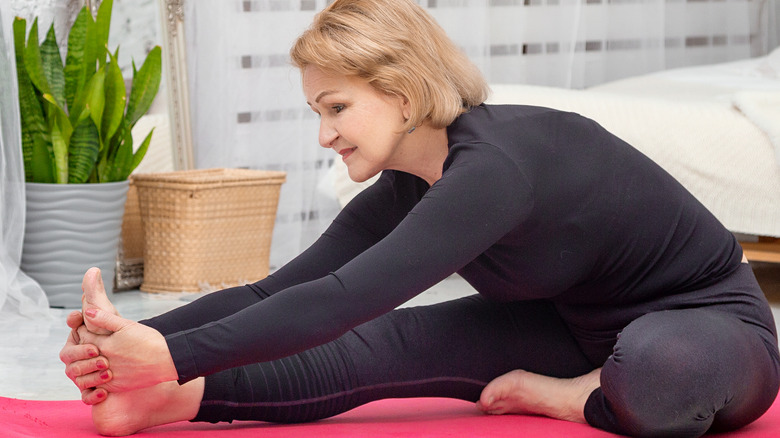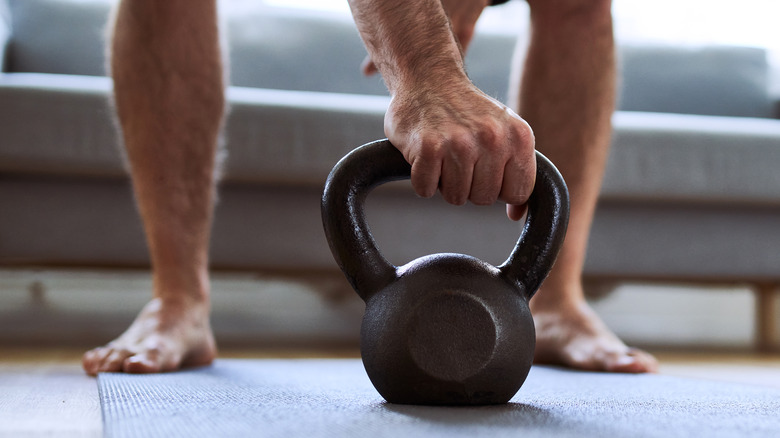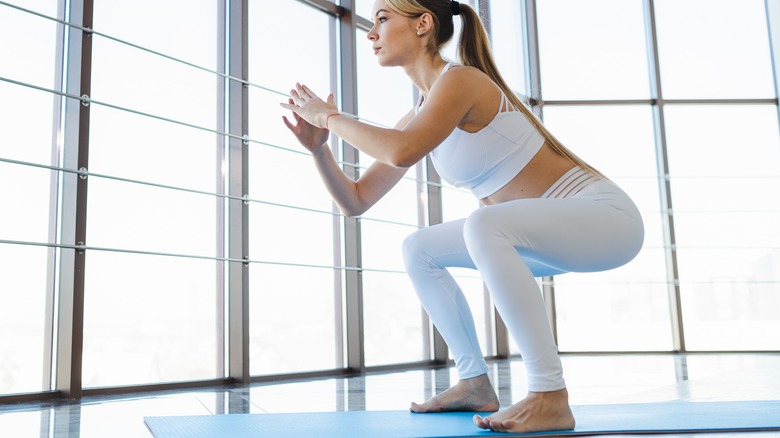Is It Safe To Work Out Barefoot?
When lifelong yogis learn that the barefoot workout is becoming a fitness trend on Instagram, they must be rolling their eyes and wondering why people don't just make a hashtag page called #makeyogagreatagain instead. While yoga is known as a physical practice that doesn't require footgear, working out barefoot is not limited to yoga. There are many non-yoga exercises that you can do without shoes, such as squats and lunges.
The human foot, per a study in StatPearls, has 29 different muscles, 26 bones, 33 joints, and over 100 tendons. When you wear shoes when working out, you only engage a snippet of the muscles in your feet. For example, how can you do toe exercises or stretch your plantar fascia if you always have shoes on? According to celebrity trainer Ridge Davis (via ASweatLife), if you want to engage the often-neglected glutes and cores in your feet and gain more from your workout, dare to workout bare.
So, is working out barefoot a boom or just a buzzword? Here's what to expect when you lose the shoes for your daily dozens.
Benefits of barefoot workouts
Common foot problems such as hammer toes, Achilles tendinopathy, pronation, and bunions are caused by shoes, says health fitness author and coach Martin Rooney (via Men's Health). "When you stub your foot in a shoe all day, it makes your foot muscles, tendons, and ligaments weak," Rooney tells the outlet. Therefore, to increase foot strength for better footwork, gym goers should exercise in bare feet, the foundation of the body and are covered in sensory receptors. When you're back in shoes after being accustomed to training with bare feet, you'll move and feel better.
Exercising without shoes may help with natural arch support, improve balance, and enhance athletic performance, personal training coach Jesse Frank tells Byrdie. The reason is that the muscles in your feet have to apply more force when they're not supported by comfy footgear, thus building crucial strength in your arches and ankles. When your arches and ankles are strong, your body is held in a balanced position, without which you can neither walk nor run properly. Some exercises to build stronger ankles, toes, and heels include dorsiflexion, pushups, deadlifts, lunges, and sprints.
You shouldn't always work out barefoot
While training barefoot helps you strengthen overall stability, it's not always the best option. When you train with heavy weights, you need shoes for decent cushioning against rogue weights to reduce your risk of sustaining a serious injury, says podiatrist Dr. Rob Conenello (via Tonal). Those with pre-existing foot injuries or mobility imbalance should make a point of wearing footgear while training unless told otherwise by an expert. Besides, you should only train barefoot when standing on a flat surface in the comfort of your own home or a squeaky clean gym. If your daily workout routine involves running on the streets or into the woods, you need to lace up to protect your feet from gravel and hard concrete.
In case you have a hard time getting used to training barefoot but crave its massive benefits, you could start off with minimalist shoes, also known as barefoot shoes. Minimalist footwear is designed to interfere as little as possible with your feet's natural motion, which helps build your muscles and tendons, a study in the Journal of Science and Medicine in Sport notes. Other than that, working out barefoot can help you develop a sharper perception of your muscle connections and enhance your overall athletic performance.


